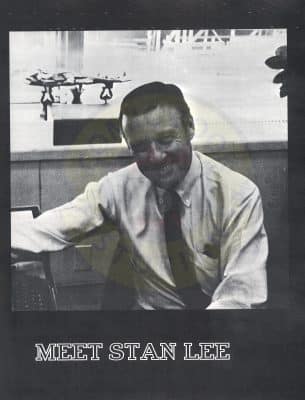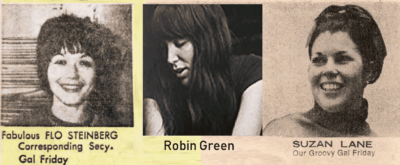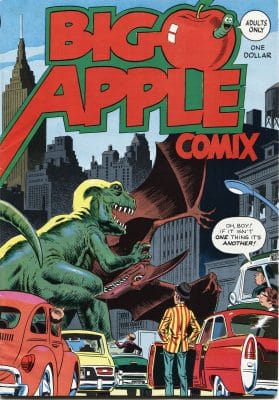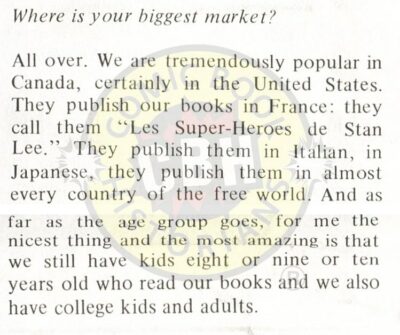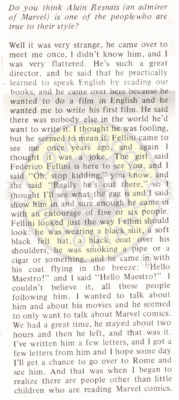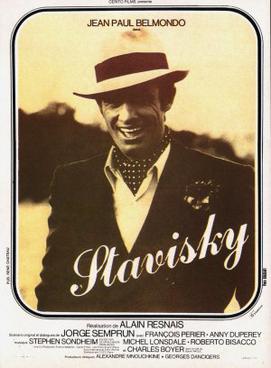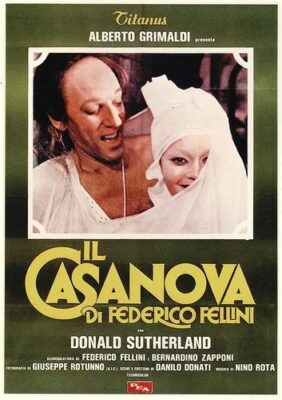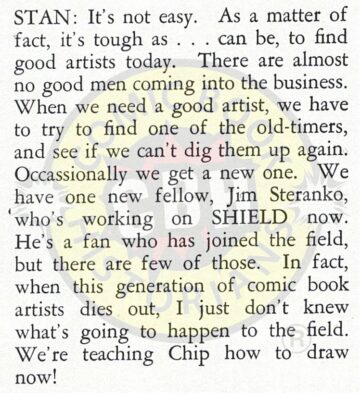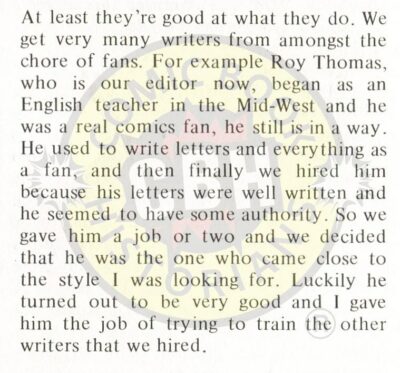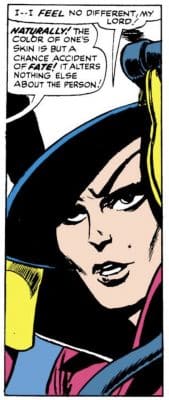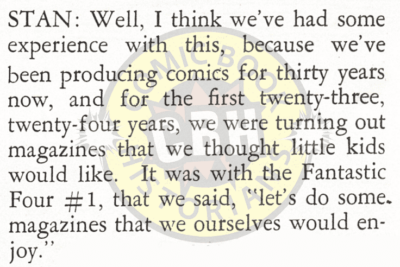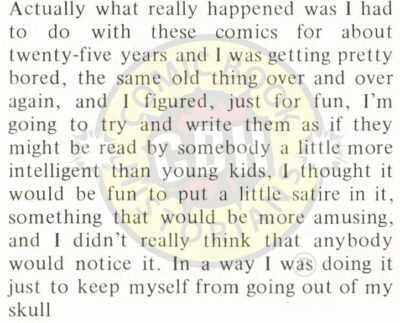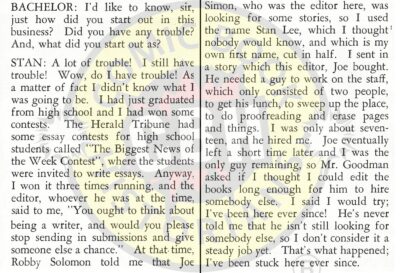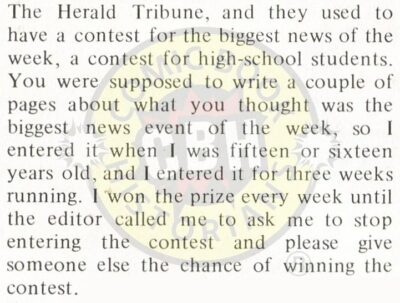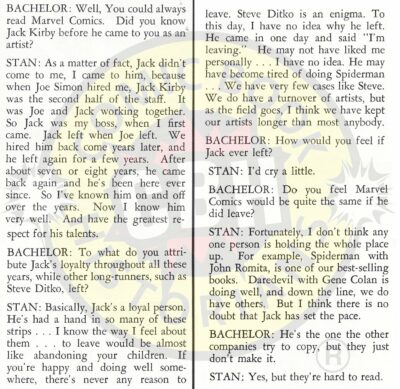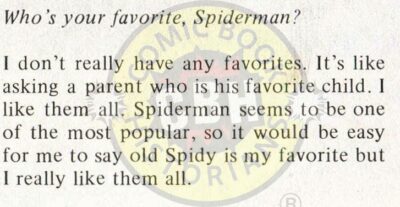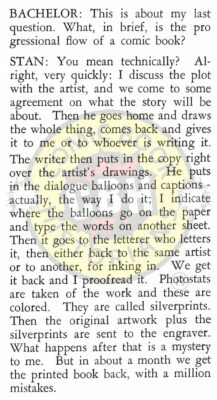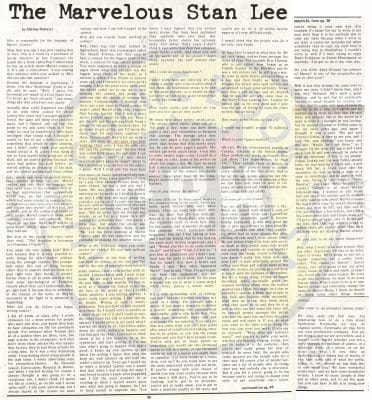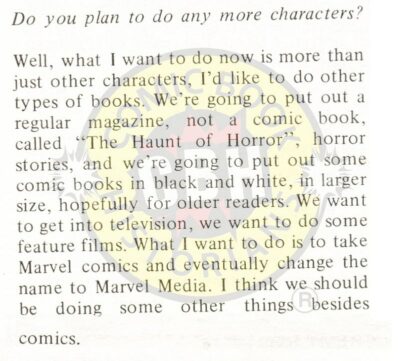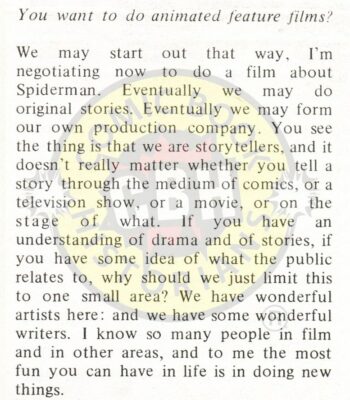There are Two Stan Lee’s by Alex Grand
Read Alex Grand’s Understanding Superhero Comic Books published by McFarland Books in 2023 with Foreword by Jim Steranko with editorial reviews by comic book professionals, Jim Shooter, Tom Palmer, Tom DeFalco, Danny Fingeroth, Alex Segura, Carl Potts, Guy Dorian Sr. and more.
In the meantime enjoy the show:
One of the fun things about rummaging through old magazines is finding interviews at various years and getting a sense of where a comic or comic creator was at that point in their life. Stan Lee is the co-creator of the Marvel Universe, Marvel brand and key Marvel characters along with Jack Kirby, Steve Ditko and other co-plotting artists who worked as independent contractors at the mythical and mostly non existent Marvel bullpen.
Stan was a public relations genius with a real knack for promotion, dialogue, and a written and spoken voice that could connect with his readers / viewers. Through the Marvel method, he gave Kirby and Ditko the creative latitude to express themselves and visually tell the stories in their own way. Stan would edit, co-plot and oversee that all the pieces and characters fit together in New York. Generally fans and historians agree that those three created something special during the 1960s, and although we have a sense of the product in various media, comics, video games, magazines, film, we still don’t have very much of an impression of who is Stan Lee? Danny Fingeroth’s book on A Marvelous Life: The Amazing Story of Stan Lee provides a great detailed study, and it’s recommended for people to read his biography. However, it’s also a fun exercise to find old interviews with Stan Lee and try to compare and contrast them by tone, details he leaves in or out, and analyze it within the corporate context of his life. This is heavily done in the Marvel Controversy article found here.
Let’s first read his 1968 Interview in Bachelor #1, a college Magazine, as the image above is the cover of the story found in the interior, here are the next 4 pages. Let’s analyze each one.
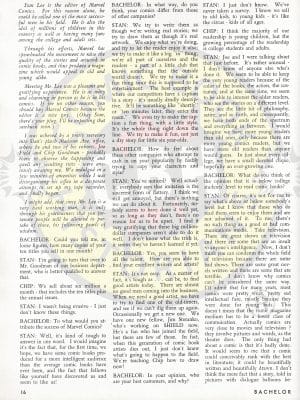
The writer was ushered into Stan’s office by a pretty secretary. Flo Steinberg left Marvel Comics the same year this article was published, in 1968 as the boss, Publisher Martin Goodman didn’t want to grant a raise. Flo’s picture from 1964 Marvel Bullpen photo is shown directly below. Flo was replaced by Robin Green who eventually became Rolling Stone’s first female journalist, so the pretty secretary is one of these two. In 1969, Robin was replaced by Suzan Lane who made it into a 1969 Marvel Bullpen photo set.
Flo left and became a publisher in her own right, and later published Big Apple Comix in 1975 with a cover by her good friend, Wally Wood.
A fun addition to this interview is that we have Chip Goodman listening in on the interview and commenting. Clearly, Stan is the verbal storyteller here and the subject of the interview due to his connection with the fans, but Chip Goodman is the son of Marvel’s owner, Martin Goodman. Martin intended to Chip to take over, and in 1972, he left the company and the new owners had total control of Marvel and chose Stan Lee to become publisher over Chip Goodman. Hence Chip left with his dad and they started the failed Atlas Comics in 1974/5. Chip ran a men’s magazine, Swank after Atlas comics failed and died at age 55 in 1994. During our Comic Book Historians podcast interview with David Anthony Kraft, former publisher of Comics Interview Magazine, reported that Chip was gay and always with a beautiful woman who was likely getting photographed for the magazine.
************************************************
*************************************************
Chip’s dysfunctional relationship with his father was satirized by Ivan Prashker in the story, “The Boss’ Son” published in Playboy Feb 1970.
Here however, we have a moment in time saved where Chip is essentially Stan’s boss and clearly the numbers guy when he answers, “we sell about six million a month, that includes the ten titles plus the annual issues.” His answer is not as charismatic as Stan’s answers, but it shows where his head is at, likely studying his father’s role as publisher. In 1973, Andy Warhol Interview Magazine, Stan knows the answer as he is publisher now since 1972.
This number 70 million a year in 1973 is roughly close to 6 million a month for a 12 month-year, which comes out about the same.
Chip also studies the demographic’s of Marvel’s readers as he mentions, “…the majority of our readership is young children, but the growing percentage of the readership is college students and adults.” Stan follows up by saying that kids are attracted to “the color of the books, the action, the costumes… older readers … see the little bit of philosophy, satire… both ends of the spectrum and everything in between…” Stan is definitely discussing his consistent diatribe that is the same in generally every interview he’s done that the Marvel brand was generally about making comics more intelligent so that both kids and young adults and even adults can enjoy them.
Stan Lee, as publisher goes over his demographic of Marvel readers in 1973.
We also get the idea that a publisher knows the demographic of his readers. In the 1973 interview, Stan goes deeper into his knowledge of demographics beyond little kids by mentioning personal anecdotes of European filmmakers Alain Resnais and Federico Fellini who stopped by to meet him to discuss Marvel Comics.
Alain Resnais is a famous French filmmaker died in 2014, skilled in many aspects of producing and directing a film.
After meeting Stan Lee, he made the film Stavisky, about the last several months of the life of con artist Serge Alexandre, exploring his youth as well as his fraud schemes with various wealthy familes. This film was written by Jorge Semprún.
Federico Fellini was an italian filmmaker and screenwriter who was hot off the heels with the release of his film Amarcord in 1973 when he met Stan Lee.
After meeting Stan Lee, his next film was Il Casanova with Donald Sutherland about a womanizer which released in 1976.
He was a little older than Alain Resnais and died in 1993.
The 1968 interview asks how he feels when other companies try to copy his characters and style. This is likely in reference to DC editors trying to be hip, or Jerry Siegel’s attempt to make the Mighty Comics Group from 1965 to 1966 with the Archie superheroes, and they just couldn’t quite touch Stan’s resonance with the youth of the day.
Stan answers honestly, “I think we still get annoyed, but there’s nothing we can do about it… nobody seems to have done it well yet, so as long as they don’t, there no reason for us to be upset.” It is nice to read verbal confirmation of him getting annoyed by this.
He says that in 1968, there were almost no good artists, and no good men coming into the business and that he has to find old timer artists. He also mentions that occasionally there are new ones. “We have one new fellow, Jim Steranko… working on SHIELD… a fan who has joined the field.”
Jim Steranko and Stan Lee had their fair share of ups and downs, but were very fond of one another. Jim spoke on the Comic Book Historians podcast about working on SHIELD under Stan Lee here:
*************************************************
In the 1973 Andy Warhold Interview with Stan, he also glowingly mentions another fan and protege turned pro, Roy Thomas.
Stan is also consistent in the last paragraph of the first page where he defends the medium of comics books as having both good and bad content, and that it can be a serious story telling device. He has been the comic book’s cheerleader for decades.
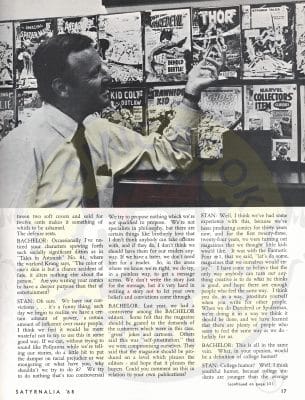
In modern times, we discuss if there are stories that are socially relevant, and the interviewer here asks Stan of his “socially significant ditties as in ‘Tales to Astonish 81’ [1966]”
This is in reference to blue-skinned Atlantean villain, Krang changing into pink skin to begin his next attack on the Sub-Mariner. Stan mentions, “we have our convictions… certain amount of influence over people…there are certain things like brotherly love that I don’t think anybody can take offense…if they do, I don’t think we should have them for our readers anyway.” This is an interesting side of Stan that shows his pontifications on life made their way into his soapbox and into the dialogue balloons of various comic characters with a purpose.
Stan also mentions from his 1968 perspective that for 24 years “we were turning out magazines that we thought little kids would like.” He goes on to say, “it was with the Fantastic Four 1 [1961] that we said, “let’s do some magazines that we ourselves would enjoy.” In the 1970s Fanzines like FOOM, they would all report that the Marvel Age started with that comic, but it is interesting to hear him talking about it at this time. FOOM 1,1973, phrased it like Stan himself is solely responsible for the Marvel Age of Comics.
In 1968, he mentions it as a “we” term and a collaborative effort which readers can see in the Marvel Controversy article, changes as time goes on like shown in the Marvel Fanzine, FOOM 1, 1973.
In the same year, in Andy Warhol Interview Magazine 30, 1973 Stan tells the same story of entertaining people who were a little more intelligent than young kids, and that he thought it would be fun to put satire in it.
In this interview, Stan has changed it form “we” to “I” which gives a less collaborative picture of his origination of the Marvel style and more of a centralist leading role.
As a dialogue writer, he mentions on the third article page that “when you’re college age, the offbeat… humor that tears away a bit from the establishment is… favored… they’re rebels.” This observation is consistent with the Thing and Spider-Man being outsiders who poked at the establishment, as opposed to the formal approach by the branded science fiction problem solving approaches to dialogue over at the Distinguished Competition.
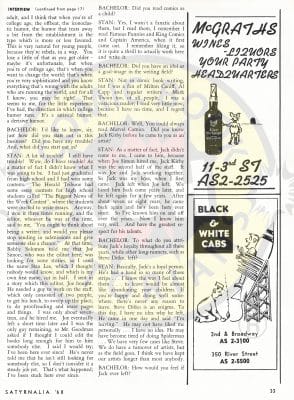
This third page gets really interesting as how 1968 Stan Lee acknowledges his start in comics working for Joe Simon and Jack Kirby.
It seems rare to see what were Stan’s writing inspirations in the comic world, and here he mentions Famous Funnies, King Comics, and Captain America which is interesting since he wrote short story in Captain America Comics 3, 1941.
He also mentions that his favorite writers were famous newspaper comic strip writer-artists like Milton Caniff, Al Capp and “regular writers – Mark Twain.”
Stan specifically mentions winning The Herald Tribune contests three times, and that he got a job through Robby Solomon for Joe Simon proofreading pages, and eventually replacing Joe when he left. He mentions Jack Kirby in the follow up questions. Let’s compare this to his description of getting his start in getting his writing recognized in Andy Warhol Interview Magazine#30, 1973.
There is an additional note that the Editor called him “to ask him to stop entering the contest and please give someone else the chance of winning.” Is this an exaggeration that he added as time went by? That’s likely as it wasn’t present earlier when the memory was more fresh. He then discusses working for Goodman, Simon and Kirby, but completely omits all their names in 1973.
There could be a sense that Jack Kirby had left Marvel in 1970, Martin Goodman left in 1972 and that he was now publisher and likely didn’t feel that promoting their names were important. He could also feel that the person asking him questions from Warhol’s magazine wouldn’t know who those names were as opposed to Bachelor magazine, and this could have been a benign omission. That is up to the reader to decide.
On the third and fourth page, the interviewer in the 1968 interview asks him about his Marvel co-creator, Jack Kirby who was still in the company at this point and wouldn’t leave Marvel until two years later.
This is interesting as we are likely getting a much more genuine assessment of Jack Kirby from Stan than in future interviews after Kirby had already left Marvel. He credits Jack as being one of the two guys he worked for, that he is a loyal person, mentions that Steve Ditko’s departure was puzzling, and that if Jack left, he would “cry a little.” He mentions that he structured Marvel to be able to survive if Jack left the company, but that when it comes to the company product, “there is no doubt that Jack has set the pace.” He also mentions that Jack leaving Marvel and its characters would be the way Stan feels about them, as “abandoning your children” which implies that they are both the character’s parents.
Stan Lee uses the children metaphor again in Andy Warhol Interview 30, 1973.
The interviewer asks him what is his favorite character, and if it is Spider-Man? Stan replies that it is like “asking a parent who is his favorite child… I like them all… I really like them all.” The main difference here is that Jack Kirby, the other parent, is omitted here as this was after Jack left for DC and before he returned back to Marvel in 1975.
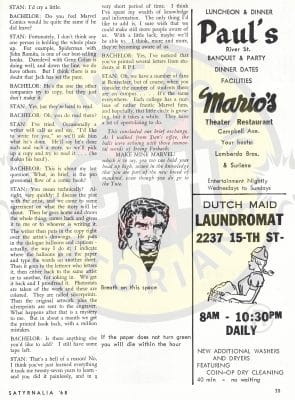
Finally on the last page, Stan gives a really interesting and transparent description of the Marvel Method. He and the artist go back and forth on a plot, which requires an agreement from the artist, then the artist draws the whole thing, then the writer puts in the copyright over the artist’s drawings, puts dialogue balloons and captions through a letterer, gets inked, then photostats are colored and called silverprints. Then the original artwork and the silverprints are sent to the engraver. Then the printed book product is given to Marvel to sell.
Stan is really showing that when he is writing, it is different than someone like Alan Moore writing a full script. There are artistic advantages as the artist can work more loosely and create more, and realistically it also makes the artist a co-writer. That’s another story that is more discussed in the Marvel Controversy article.
There have been some examples shown here from Andy Warhol Interview Magazine 30, 1973. It would behoove a reader to read that in its entirety so here it is:
Stan talks about his fans and readership when he talks about the letters coming in saying that in the past “I read every letter… I really love these kids… and now I try to have somebody around the office to read them.” This shows the reader in likely an honest fashion that he connected with his fans because he loved them, and loved being the object of their fandom. He probably loved being their hero.
When Stan is asked in 1973 if he plans to do any more characters, he mentions that he wants to put out different genre’s into the black and white magazine format for older readers.
Rick Marschall edited this line of magazines in the later 1970s, and anyone can click here to see his insight into working with Stan and editing those magazines. He also hints at the future, as publisher he is looking at the big picture and he wants to push Marvel into other media like television and films, maybe change the name to Marvel Media. This definitely foreshadows his producer role in the Hulk, Spider-Man and Dr. Strange TV show(s) in the late 1970s and his move into Los Angeles to work in the Marvel animation studio working on various projects like the X-Men pilot and the King Features, Defenders of the Earth cartoon in the 1980s.
The value in these interviews is to see where these comic creators mentally are in time, and also see how their recollection of the past either evolves or devolves or stays consistent throughout the decades. A sample from FOOM was placed, but mostly this is a compare and contrast of where Stan was as Editor in 1968 creating and co-creating the Marvel brand and characters with Jack Kirby, and then in 1973 as a triumphant publisher whose details of same events change, but there are new details reflecting where he was in the business at that time.
cheers.
Join us for more discussion at our Facebook group
check out our CBH documentary videos on our CBH Youtube Channel
get some historic comic book shirts, pillows, etc at CBH Merchandise
check out our CBH Podcast available on Apple Podcasts, Google PlayerFM and Stitcher.
Use of images are not intended to infringe on copyright, but merely used for academic purpose.
Fantastic Four © Marvel, Amaziing Spider-Man © Marvel. Dr. Strange © Marvel, Steve Ditko articles © S. Ditko, Gary Groth interview © Comics Journal, Stan affidavit 1999 © Stan Lee Media, Origins ©Marvel, FOOM © Marvel, Dick Ayers Story © Dick Ayers, Photos ©Their Respective Copyrightholders, Stan Lee Toberoff Quote from Kirby: King of Comics









